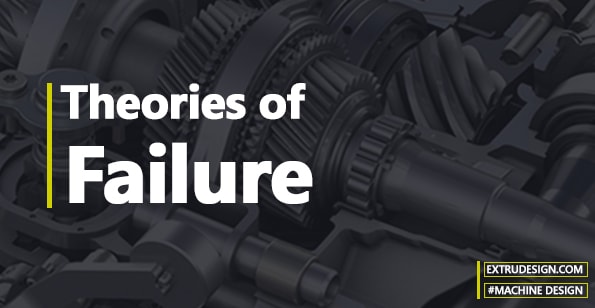Prediction of the failure of the machine component in the case of the uniaxial stresses(Simple tension or compression) is very simple by understanding the Stress-strain curve. Predicting the failure of any machine component is complicated when the machine component is subjected to the different types of Bi-axial stresses(Component subjected to two different stresses) or Tri-axial stresses (Component subjected to three different stresses). There are different theories of failure are evolved.

Various Theories of Failure
Following are the different theories of failure evolved when a machine component is subjected to different types of Bi-axial stresses(Component subjected to two different stresses) or Tri-axial stresses (Component subjected to three different stresses).
- Maximum principal (or normal) stress theory
- Maximum shear stress theory
- Maximum principal (or normal) strain theory
- Maximum strain energy theory
- Maximum distortion energy theory
Let’s discuss all of them with at which point the failure occurs and what kind of materials can be applicable to the above different kind of theories of failures.
Maximum principal stress theory
- Maximum Principle theory is also known as Rankine’s theory.
- Failure occurs at a point in a machine member when the maximum Principle stress in a bi-axial stress system reaches the limiting strength of the material in a simple tension test.
- The limiting strength of the material means the yield point for ductile materials.
- For brittle materials, The limiting strength of the material would be the ultimate stress.
- But this theory of failure is applicable in the Brittle materials only.
- Not applicable for the Ductile materials due to this principle applicable if the failure occurs due to the tension or compression. Not applicable for the shearing.
Maximum shear stress theory
- Maximum shear stress theory is also known as Guest’s or Tresca’s theory.
- Failure occurs at a point in a machine member when the maximum shear stress in a bi-axial stress system reaches the value equal to the shear stress at yield point in a simple tension test.
- This theory is used for the ductile material machine members.
Maximum principal strain theory
- Maximum principal (or normal) strain theory is also known as Saint Venant theory.
- Failure occurs at a point in a machine member when the maximum principal strain in a bi-axial stress system reaches the limiting value of strain in a simple tension test.
- Limiting strain means the yield point of the material.
- This maximum Principal strain theory is generally not used. It meant to use for the particular case where reliable results are required.
Maximum strain energy theory
- Maximum strain energy theory is also known as Haigh’s theory.
- Failure occurs at a point in a machine member when the strain energy per unit volume in a bi-axial stress system reaches the limiting strain energy per unit volume in a simple tension test.
- Limiting strain energy means the strain energy at the yield point of the material
- This theory is can be used for the Ductile materials.
Maximum distortion energy theory
- Maximum distortion energy theory is also known as Hencky and Von Mises theory.
- Distortion energy means Shear strain energy which is equal to the difference between the total strain energy and the strain due to the uniform stress.
- Failure occurs at a point in a machine member when the distortion strain energy per unit volume in a bi-axial stress system reaches the limiting distortion energy per unit volume in a simple tension test.
- This theory is can be used for the Ductile materials in place of the Maximum strain energy theory.
These are the different theories of failures which help to predict the failure of any machine component is complicated when the machine element is subjected to the different types of Bi-axial stresses(Component subjected to two different stresses) or Tri-axial stresses (Component subjected to three different stresses).

Leave a Reply